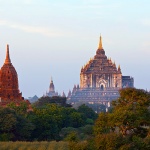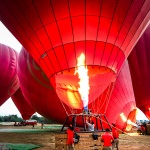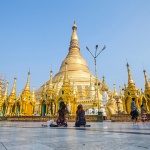
By Uma Mageshwary Gunasakaran
Our first impression of Mandalay upon arrival was that it was just another city like Yangon. However, as we browsed through the attractions map provided by Bagan King Hotel, where my friend and I stayed for 3 days, that impression was quickly transformed.
Geographically, Mandalay was developed on a plain at the foot of Mandalay Hill, which is believed to be sacred. It was made the religious centre by the Ava Kingdom in the late 1800s. Mandalay’s location by the Ayeyarwady River – strategic for trade, food resources and as a transportation hub – explains why it was chosen to be the capital of northern Myanmar then.
To explore what the city had to offer, we narrowed down our itinerary to a few places of interest that we thought would best give us a taste of Mandalay’s culture, history, scenery and gastronomical delight.
An Early Start
We started our day before the crack of dawn. Hiring a thone bane, which is essentially a three-wheeler, with our Grab app was convenient. Our ride to the southern foot of Mandalay Hill cost 3,000 Kyats. When we arrived, hardly anyone was around.
There are a few ways to get to the top of Mandalay Hill – by taxi or thone bane, taking an escalator, or climbing up the covered walkway of 1,700 steps. Deciding that a morning workout would do us good, we took the stairs.
As footwear were not allowed, we carried our shoes in a bag. Halfway up, we came across a gilded statue of Buddha, Byar Deik Paye, pointing towards the Mandalay Palace. After 40 minutes of climbing, we arrived at one of the shiniest temples we had ever seen – the Su Taung Pyi Pagoda.
The walls and pillars were laced with colourful and shiny mirror-like mosaic tiles. As the sun slowly rose and cast its golden beam on the pagoda, there was no doubt that the 240-metre hike up in the wee hours of the morning would be our best decision made that day.
Blessed with clear skies, we savoured a bird’s-eye view of Mandalay from here. A popular spot to catch the sunset, Mandalay Hill was significantly less crowded at dawn. In this peaceful atmosphere, we witnessed people below emerging from their houses, the traffic slowly building up, and the city of Mandalay coming to life.
To protect our knees, we opted to not take the stairs back down and hired a Grab thone bane to Kuthodaw Pagoda instead. Kuthodaw is famed for housing the world’s largest book in the form of 729 marble slabs inscribed with Buddha’s teachings on both sides.
Each slab is placed in a small white shrine called kyauksa gu, creating a spectacularly organised pattern of 729 golden-spired white stupas surrounding the main pagoda, especially when viewed from above. We caught a glimpse of it from the top of Mandalay Hill and were truly intrigued, for we had seen nothing like it.
A neighbouring pagoda called Sandamuni is a 20-year-younger and whiter version of the Kuthodaw. It encases 1,774 marble slabs in smaller stupas, in the same arrangement as Kuthodaw’s. Yet, it is not as popular. We discovered it by chance after exiting Kuthodaw Pagoda via the south gate and turning right.
Though the stupas of Sandamuni Pagoda are crammed into a smaller space, it was a quieter visit. A 5-minute walk from there brought us to the Shwenandaw Monastery, one of the most well-preserved teakwood buildings to survive World War II.
This beautiful monastery promises to captivate the heart of any art lover. Every inch of its interior and exterior walls, covered with intricate and detailed carvings, is a paragon of Burmese carpentry. Wooden panels inside the monastery, containing carvings depicting the previous lives of Buddha, are the most well preserved as they are sheltered from the elements.
Revisiting Former Glory
Contented with our visit to Shwenandaw Monastery, we travelled by thone bane to the Mandalay Palace just 10 minutes away. The palace represents the heart of Mandalay. It is located on a 4-square-kilometre land surrounded by a moat with an entrance on each side. However, only the east entrance is accessible to tourists.
The current palace is actually a 1990s reconstruction of the original that was devastated by a fire during World War II. The original Mandalay Palace was built by King Mingdon to symbolise Mandalay as the royal capital city of Burma in 1857. However, the glory of his kingdom was short-lived as the British empire invaded Burma and captured the royal family in 1885.
Therefore, Mandalay Palace represents the last monarchy of Myanmar. Today, visitors are only allowed to follow a designated pathway to the palace, as the rest of the area is a restricted military zone. When we were there, we saw big signs everywhere reminding us not to wander.
Although the reconstruction incorporated traditional techniques and designs, the palace exuded the aura of a modern-day building. We walked around admiring the complex for a few minutes before heading to Mingalabar Restaurant for brunch.
The restaurant is highly rated among locals and foreigners alike for its wide variety of dishes and rich flavours. One of the best dishes we had in Myanmar was the pork curry with dried mango served here. Succulent chunks of meat braised in thick garlicky and tangy gravy – it was out of this world.
After only half a day in the city, we couldn’t help but fall for the charm of Mandalay.










